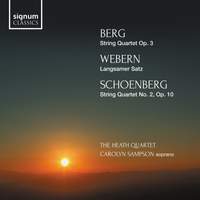Recording of the Week,
Berg, Webern and Schoenberg from the Heath Quartet
Formed at the Royal Northern College of Music in 2002, the Heath Quartet made an astonishing recording debut back in 2015 with a set of Tippett’s complete string quartets which scooped the Chamber prize at the following year’s Gramophone Awards, thanks to the clarity and beauty which the group brought to a body of works that can so easily seem rather thorny and forbidding in lesser hands. In the intervening years they’ve gone from strength to strength, with live projects including TS Eliot’s Four Quartets with Jeremy Irons and Alex Jennings, and a recording of the complete Bartók quartets earning them a second Gramophone Award nomination in 2017.
 For their debut recording on Signum (released earlier this month), they’ve chosen to focus on the music of the Second Viennese School, with a trio of works composed between 1905 and 1910 which see Schoenberg and his two star pupils Berg and Webern pushing tonality to (and even beyond) its very limits as well as exploring virtually every possible colour and texture which the string quartet has to offer.
For their debut recording on Signum (released earlier this month), they’ve chosen to focus on the music of the Second Viennese School, with a trio of works composed between 1905 and 1910 which see Schoenberg and his two star pupils Berg and Webern pushing tonality to (and even beyond) its very limits as well as exploring virtually every possible colour and texture which the string quartet has to offer.
We open with Berg’s String Quartet Op. 3, written towards the end of his formal studies with Schoenberg and inspired in part by the latter’s String Quartet No. 2 (which in a nifty bit of symmetry closes the album). As Douglas Jarman points out in a booklet-note which matches the lucidity of the playing here, Schoenberg himself remarked after Berg’s death that the work ‘surprised me in the most unbelievable way by the fulness and constraint of its musical language’, and the Heaths are the most compelling and sure-footed of guides throughout this twenty-minute journey across unpredictable musical terrain.
One feels that all four players have a firm grasp on exactly where the music’s headed as Berg confounds our harmonic expectations at every turn, thanks in part to the beautifully-judged balance between the voices and the immaculate intonation which never falters even in the numerous taxing passages which the composer stipulates should be played high on the lower strings of the instrument despite easier options being available…
What’s also striking is their scrupulous observance of the many and varied markings in Berg’s score: perhaps because he wasn’t a string-player himself, the young composer micro-manages virtually every nuance of the music, specifying exactly where the bow should sit on the fingerboard and making full use of mutes and col legno technique as well as notating each dynamic shift in painstaking detail. But the marvellous thing about this performance is the way the Heaths balance absolute textual fidelity with a sense of spontaneity – the expressive portamenti in the opening pages are a case in point, as are the subtle variations in vibrato (one aspect which Berg doesn’t prescribe!) throughout.
Coming after Berg’s almost complete break with tonality, Webern’s Langsamer Satz (composed during a walking-holiday with his future wife) makes for the most delicious of palette-cleansers, sounding almost Brahmsian by comparison, and the Heaths bask in its rhapsodic singing lines and more predictable harmonic language – the clean, almost ascetic quality of their playing in the Berg is here replaced by full-fat tone, warm vibrato and generous (but never over-indulgent) rubato.
 The final work on the album is Schoenberg’s String Quartet No. 2, something of a Portrait of the Artist on several levels: suffused with anxiety and melancholy born out of a difficult time in his marriage to Mathilde Zemlinsky, it also charts the composer’s own journey from late Romanticism to atonality, the relatively conventional first movement giving way to a finale in which tonal centres are ‘dissolved in swirling sound’, to quote the Stefan Georg poem which Schoenberg sets here.
The final work on the album is Schoenberg’s String Quartet No. 2, something of a Portrait of the Artist on several levels: suffused with anxiety and melancholy born out of a difficult time in his marriage to Mathilde Zemlinsky, it also charts the composer’s own journey from late Romanticism to atonality, the relatively conventional first movement giving way to a finale in which tonal centres are ‘dissolved in swirling sound’, to quote the Stefan Georg poem which Schoenberg sets here.
The quartet is joined by Carolyn Sampson for the last two movements, and what a contribution she makes: her crystal-clear soprano complements the string sound quite beautifully, though where required there’s also a thrilling weight to the sound which I’d never heard this singer summon before (Schoenberg tasks her with a two-octave leap reminiscent of Wagner’s Kundry at one point!). She and the quartet are ever-sensitive to the mystical beauty of Georg’s poetry, painting the ‘hazy vapours’ and ‘holy fire’ in the most vivid of colours as this superb album draws to a transcendent close.
Heath Quartet, Carolyn Sampson (soprano)
Available Formats: CD, MP3, FLAC, Hi-Res FLAC



